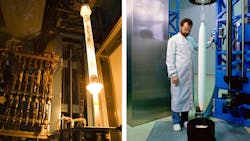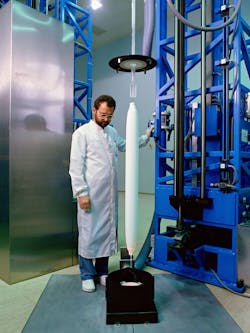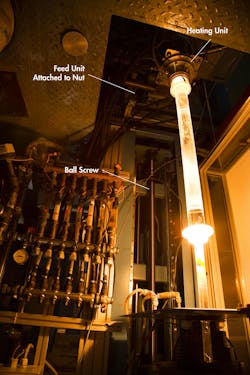Ball Screws Help Create Fiber-Optic Cable for 5G Communications
Fundamental ball-screw technology hasn’t changed much since 1929 when Rudolph G. Boehm patented a device he called an “anti-friction” nut. The ability to smoothly and precisely move heavy loads is a key process in a long list of industries. Nowhere is this more evident than in the factories turning out fiber-optic filaments to meet demands stemming from the 5G communications and relying on ball screws to do it.
Wireless carriers are just beginning to roll out 5G communications, but even the most conservative estimates project at least a tenfold speed increase over 4G. This will affect everything from cell phones and laptops to driverless cars.
5G communications is boosting the demand for high-bandwidth fiber optic cable, which requires continuous improvement in making fiber optics. The current process starts with making highly treated, multilayered silicon rods called preforms. These provide the silicon that will be drawn into filaments approximately the width of a human hair and joined with hundreds of similar strands to produce fiber-optic transmission cables that can carry 5G signals.
To start the conversion of the preform into a single strand, a technician climbs to the top of a drawing tower and loads it into a feed mechanism that will lower it into a high-temperature furnace. Once the preform arrives at the heating element, gravity takes over, and the molten silicon drips and narrows to its intended diameter. As it cools and hardens, the filament passes through a laser micrometer to assure 99% width consistency. It is then pulled onto a take-up spool that gathers almost 33,000 feet of filament before it goes on to be made part of a completed cable.
The speed at which preforms are fed into the furnace is critical. The thin fiber can only take slow and steady movement (one meter per hour) to ensure production is stable. Any faster, the furnace can’t melt the preform fast enough. Any slower, the stream will lose continuity. To get the best results, many of the world’s leading fiber-optic producers use ball screws for their consistent and smooth movement at such low speeds.
In a typical fiber plant, the feed mechanism is anchored to the ball screw nut with a rod. The nut rides down the vertically positioned ball screw, carrying the preform feed mechanism towards the heater. Requisite travel distance from the top of the drawing tower to the furnace is 236 to 315 in., which requires a long screw.
To get the best (and most) cable, three factors must be taken into account:
Pitch diameter. Speed control and efficiency are affected by the screw’s pitch. Standard dimensions such as 1.98 × 0.39, 2.48 × 0.39 and 3.15 × 0.39 in. are ideal for slow and steady filament production.
Long strokes. Preforms travel about 20 ft. from insertion to the heater six}. This takes a screw at least 26 ft. long, which the ball screw can handle and companies supply.
Diameter. The screw’s diameter affect the machine’s durability and its motion’s stability. The thicker diameters, such as 1.98, 2.48 and 3.15 in., also don’t bend over the long stroke.
Automatically producing fiber-optic cable is just one way that ball screws are helping to build a new generation of communications. Thomson Industries, for example, has customers using ball screws on the doors of furnaces used to process sapphire for mobile phone screen protectors, as well as feeding electrodes to winding machines for lithium batteries destined for use in electric cars.



